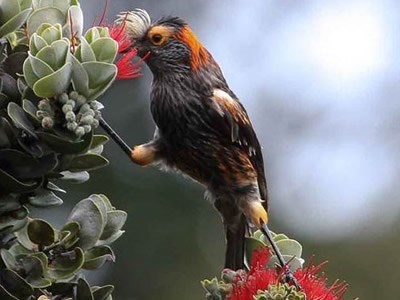
Mark Kimura ‘Apapane 
Mark Kimora (Drepanis coccinea) Status: Threatened, Vulnerable. Endemic. Adult ʻiʻiwi are an astonishing red, with striking black wings. The slender, long, pale orange-colored bill is unmistakable. These honeycreepers seek flower nectar in native and non-native trees in the Hosmer Grove area and around Palikū Cabin. Creaks, gurgles, and a “rusty hinge” sound are characteristic of the call. Hawaiian royalty prized brilliant ʻiʻiwi feathers for capes. 
Mark Kimura (Chlorodrepanis virens) Status: Not threatened. Endemic. Look for brilliantly green-yellow ʻamakihi in the Hosmer Grove area, Kalahaku Overlook, and at Palikū cabin in the backcountry. Females are slightly less vibrant. Both forage for blossom nectar and insects. ʻAmakihi are well known for their “scoldy” manner, often delivering a buzzy “tzeet” at birdwatchers. ʻAmakihi may be developing a resistance to introduced avian malaria. 
C. Robby Kohley (Paroreomyza montana) Status: Not threatened. Endemic to East Maui. Look for this round, quick, grey-green little forest bird creeping along branches and trunks looking for insects. ʻAlauahio like forested slopes, such as Hosmer Grove and the adjacent Waikamoi Preserve. Their song consists of a repeated whistled phrase described as: “whichy-wheesee-whurdy-whew”. Small flocks of these bold birds sometimes approach birdwatchers. 
C. Robby Kohley (Pseudonestor xanthophrys) Status: Endemic. Critically Endangered. Presently only ~500 birds remain. Stocky kiwikiu, olive green above and yellow below, are named for their parrotlike bills, which they employ to split branches in search of insects in high elevation wet forests. Check for the distinctive black eye stripe as you search the Hosmer Grove area and near Palikū Cabin in the backcountry. Its call is a short “chip,” chirped every three to five seconds. Its song consists of slow, rich “cheer” notes. The kiwikiu’s original name was lost. In 2010, the Hawaiian Lexicon Committee renamed it “Kiwikiu:” “Kiwi” for its curved beak and “kiu” for its secretive behavior. 
MFBRP (Palmeria dolei) Status: Critically Endangered. Ākohekohe or Crested Honeycreeper is the largest (24-29 g) honeycreeper remaining on Maui. Primarily black with striking orange-red tipped body feathers. Its throat and breast feathers are tipped with silvery-white. They are primarily nectarivorous, but also feeds on caterpillars and spiders. Vocalizations include various guttural clucking gurgles, raspy croaks, and buzzing sounds. Saving Haleakalā's forest birdsBeauty on the Brink |
Last updated: September 14, 2023
